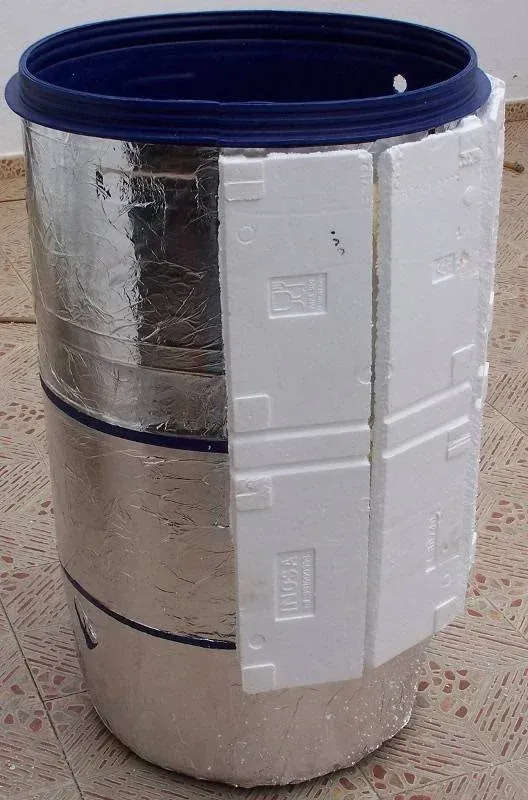
The homemade tank that we are going to build, or at least I am, will be made of plastic.
It should be noted that a plastic tank cannot be used for pressurized water (but I don't want pressurized water)
Any container that is commonly used for transporting food or liquids will do.
Plastic containers of various sizes are used in rural environments.
They are used to store water and irrigate.
Many containers are used to transport processed food, such as olives, corn, boiled carrots, etc...
This type of container for transporting food has a use-by date.
When this date is exceeded, companies need to get rid of them.
So, when that time comes, it is removed from circulation.
They can be sold for private use, as is the case of our interest.
I got my 260 litre drum from someone who was storing them for private use in a garden, at the modest price of 10€.
It will be very important to clean it several times and disinfect it very well with degreaser, bleach and hot water, we must not forget that it will be the water that will come out of our taps and we do not want strange smells.
Just like the box, the insulation can be made of anything.
We must provide several layers of the best insulating materials, or the most correct insulators that we can acquire.
For my homemade tank I have used in this order: (ordered from the inside to the outside)
As I said before, my first layer is several layers of aluminum foil.
And on top of this I apply the layers of expanded polystyrene (commonly known as white cork)
Insulating the homemade tank
The homemade tank with pieces of polystyrene glued with polyurethane foam will cover the largest possible area of the drum.
I have held the corks with a ratchet strap.
The foam swells and dries quickly, but I am not interested in leaving it too far apart.
The foam is intended to act as an adhesive, and whatever sticks out will cover the gaps between the plates.
Once the polystyrene pieces have been glued and sealed, the result should be a very well protected and very solid boat.
Homemade tank with sealing of the holes with polyurethane foam: (use 1/3 of what you think is needed, because the foam swells a lot over time)
My last layer is cardboard, to cover the whole assembly of the homemade tank.
Here I give the final touch with the foam, filling between the cork plates, and gluing the cardboard.
You can make some holes in the cardboard, to fill it and not leave air between the cardboard and the interior.
More than anything, so that the cardboard forms part of the body, and there are no malleable lumps.
Right now the homemade tank is in the state as shown in the last photo, and the insulation seems to be quite good, it loses between 5ºC-8ºC only on cold nights, not bad for a homemade assembly and taking into account that it is 260 liters of water, which is not the same as insulating 100 liters.
Finally we will cover everything to protect it from the sun.
We can cover it with weatherproof plastic, or something similar.
Or we can also cover it with some silicone paint.
The connections to the tank must be watertight.
To do this, we will make these connections with bushings.
And the temperature sensors will be coupled using "Tees".
To learn more about the coupling and installation of temperature sensors, visit the page Installation of temperature sensors Temperature Sensor Installation
I describe the connections you will need to make in the tank: (The diagram belongs to my design using fishing tube)
For variable level use, we only have 2 ways to "suck" the hot water.
Regarding point 1, nothing to comment, the disadvantage is that it will not be collecting the water from the hottest point of the tank, and I am not saying that the idea is bad.
Using a fishing tube seemed more suitable to me, and it has worked quite well for me.
A "fishing" tube consists of a tube that is submerged, but tied to some floating element that makes the tube always suck the water from the highest possible level.
This is the fishing tube:
More detailed information on this type of pressureless gravity tank can be found at Article on pressureless tank